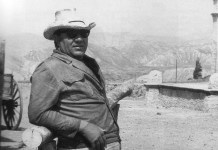Roberto Minervini has been making fascinating films that border somewhere between documentary and fiction with a singular approach that leads to stunning results. His stories have taken him around the Deep South, from whence he uncovers hidden stories that rarely see the light, at least on the big screen.
While his previous outings have looked at the impoverished underbelly of US society, often in rural settings, with rodeo cowboys and trailer park kids, What You Gonna Do When the World’s on Fire? takes us to the more urban setting of New Orleans and in a departure for the director, he’s filming in black and white. Yet there are similarities with his previous films: the protagonists are all non-professionals, who script the dialogue themselves, with Minervini creating a narrative in the editing room. The main characters are Ronaldo and Titus, half-brothers on summer break, killing time and trying to keep out of trouble. Ronaldo is a responsible young teen who nurtures his younger sibling – albeit sometimes through occasional bullying. Minervini’s Low Tide comes to mind, in which he captured the unfettered life of a young boy, and like that film it is the boys who pack the biggest emotional punch: their honesty and naturalness in front of the camera is emotionally powerful as well as often very funny.
But what separates the films is not just the colour of the film, but that of its characters, for all the performers in this film are black. The film focuses on the summer of 2017 in the aftermath of a spate of killings of black men in Louisiana. As well as Ronaldo, Titus and their mother, we also meet Judy. She has been through hard times, suffered sexual abuse, been a drug addict and spent time behind bars. Yet her compassion and resilience, and her determination not to be defeated by her circumstances, is something to behold. Her love permeates the film, whether it’s for her mother, her friends or the crack addict across the street. We also meet the New Black Panthers, a small contingent that seems almost pathetic when seen at meetings or on protests. But when we see this group in action, walking door to door in an attempt to find out the truth behind a multiple murder, or feeding the homeless below an overpass, we see that while not numerous, they are a potent force. And it is in the scene feeding the homeless that Minervini provides one of the most memorable visual moments. When a Panther hands out a soft drink, a hand appears from under a blanket and the humanity and poetry of this simple action brings tears to your eyes. Another scene that has this effect is when two men are sewing costumes for carnival. As they stitch beads and sing, the scene encapsulates all of the suffering at the hands of the white man throughout the last 200 years of American history.
And that is the other major difference with this feature, for while his other works might have contained more of these poetic moments, Roberto Minervini seems to have more pressing business to attend to. This is an important film that comes at a significant moment not only in the USA, but around the world as we witness the resurgence of fascism and white nationalism.Minervini gives a voice to the oppressed and the ignored without ever giving the impression that he is exploiting or patronising them. This work is more visceral and politically-charged, perhaps even angrier, than his previous films, whilst retaining elements of beauty and it merits a wide release.






